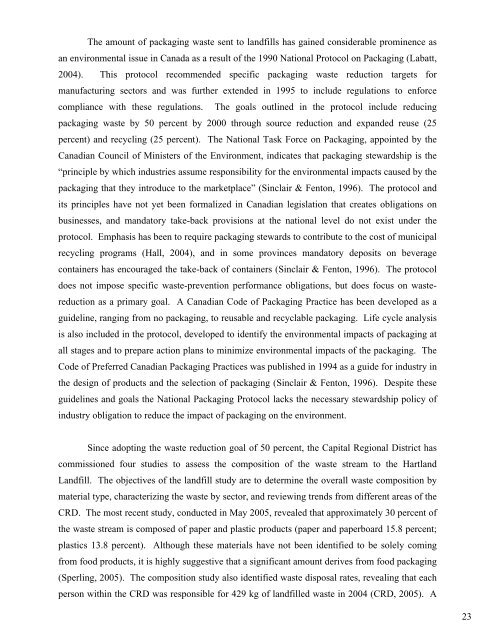Sustainable Food Production, Consumption, and the Generation of
Sustainable Food Production, Consumption, and the Generation of
Sustainable Food Production, Consumption, and the Generation of
Create successful ePaper yourself
Turn your PDF publications into a flip-book with our unique Google optimized e-Paper software.
The amount <strong>of</strong> packaging waste sent to l<strong>and</strong>fills has gained considerable prominence as<br />
an environmental issue in Canada as a result <strong>of</strong> <strong>the</strong> 1990 National Protocol on Packaging (Labatt,<br />
2004). This protocol recommended specific packaging waste reduction targets for<br />
manufacturing sectors <strong>and</strong> was fur<strong>the</strong>r extended in 1995 to include regulations to enforce<br />
compliance with <strong>the</strong>se regulations. The goals outlined in <strong>the</strong> protocol include reducing<br />
packaging waste by 50 percent by 2000 through source reduction <strong>and</strong> exp<strong>and</strong>ed reuse (25<br />
percent) <strong>and</strong> recycling (25 percent). The National Task Force on Packaging, appointed by <strong>the</strong><br />
Canadian Council <strong>of</strong> Ministers <strong>of</strong> <strong>the</strong> Environment, indicates that packaging stewardship is <strong>the</strong><br />
“principle by which industries assume responsibility for <strong>the</strong> environmental impacts caused by <strong>the</strong><br />
packaging that <strong>the</strong>y introduce to <strong>the</strong> marketplace” (Sinclair & Fenton, 1996). The protocol <strong>and</strong><br />
its principles have not yet been formalized in Canadian legislation that creates obligations on<br />
businesses, <strong>and</strong> m<strong>and</strong>atory take-back provisions at <strong>the</strong> national level do not exist under <strong>the</strong><br />
protocol. Emphasis has been to require packaging stewards to contribute to <strong>the</strong> cost <strong>of</strong> municipal<br />
recycling programs (Hall, 2004), <strong>and</strong> in some provinces m<strong>and</strong>atory deposits on beverage<br />
containers has encouraged <strong>the</strong> take-back <strong>of</strong> containers (Sinclair & Fenton, 1996). The protocol<br />
does not impose specific waste-prevention performance obligations, but does focus on wastereduction<br />
as a primary goal. A Canadian Code <strong>of</strong> Packaging Practice has been developed as a<br />
guideline, ranging from no packaging, to reusable <strong>and</strong> recyclable packaging. Life cycle analysis<br />
is also included in <strong>the</strong> protocol, developed to identify <strong>the</strong> environmental impacts <strong>of</strong> packaging at<br />
all stages <strong>and</strong> to prepare action plans to minimize environmental impacts <strong>of</strong> <strong>the</strong> packaging. The<br />
Code <strong>of</strong> Preferred Canadian Packaging Practices was published in 1994 as a guide for industry in<br />
<strong>the</strong> design <strong>of</strong> products <strong>and</strong> <strong>the</strong> selection <strong>of</strong> packaging (Sinclair & Fenton, 1996). Despite <strong>the</strong>se<br />
guidelines <strong>and</strong> goals <strong>the</strong> National Packaging Protocol lacks <strong>the</strong> necessary stewardship policy <strong>of</strong><br />
industry obligation to reduce <strong>the</strong> impact <strong>of</strong> packaging on <strong>the</strong> environment.<br />
Since adopting <strong>the</strong> waste reduction goal <strong>of</strong> 50 percent, <strong>the</strong> Capital Regional District has<br />
commissioned four studies to assess <strong>the</strong> composition <strong>of</strong> <strong>the</strong> waste stream to <strong>the</strong> Hartl<strong>and</strong><br />
L<strong>and</strong>fill. The objectives <strong>of</strong> <strong>the</strong> l<strong>and</strong>fill study are to determine <strong>the</strong> overall waste composition by<br />
material type, characterizing <strong>the</strong> waste by sector, <strong>and</strong> reviewing trends from different areas <strong>of</strong> <strong>the</strong><br />
CRD. The most recent study, conducted in May 2005, revealed that approximately 30 percent <strong>of</strong><br />
<strong>the</strong> waste stream is composed <strong>of</strong> paper <strong>and</strong> plastic products (paper <strong>and</strong> paperboard 15.8 percent;<br />
plastics 13.8 percent). Although <strong>the</strong>se materials have not been identified to be solely coming<br />
from food products, it is highly suggestive that a significant amount derives from food packaging<br />
(Sperling, 2005). The composition study also identified waste disposal rates, revealing that each<br />
person within <strong>the</strong> CRD was responsible for 429 kg <strong>of</strong> l<strong>and</strong>filled waste in 2004 (CRD, 2005). A<br />
23











